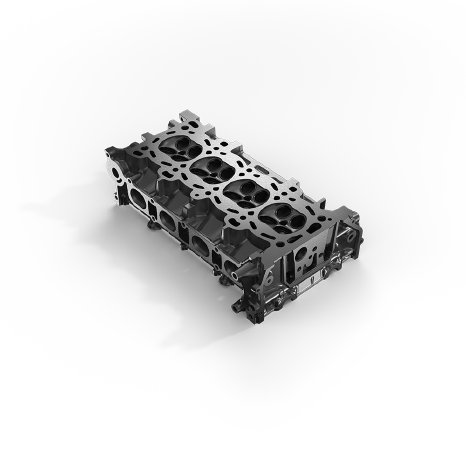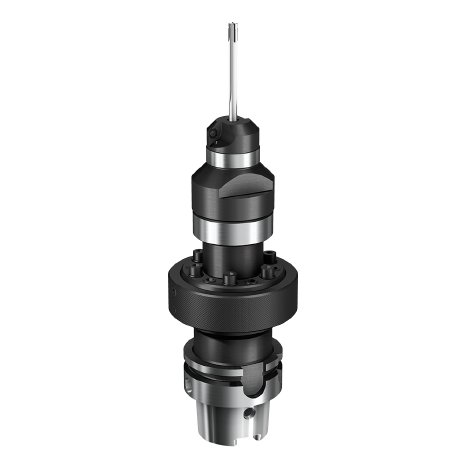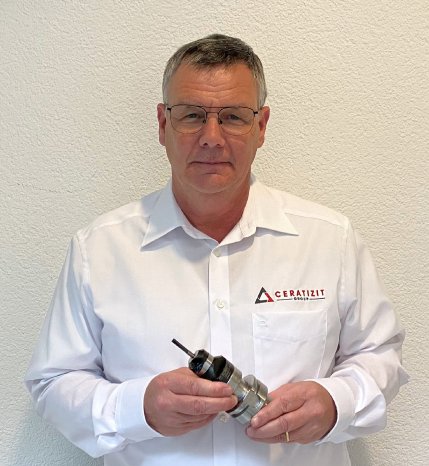The new Ceratizit tool system for high-precision, cost-effective valve seat machining consists of two similarly structured multi-functional tools: one for the semi-finishing of the intake and exhaust with a pilot reamer for the valve guide and cutting edges for the valve ring, and another for the finish machining of the intake and exhaust with a finish reamer and finish cutting edge for the sealing chamfer on the valve ring.
Each of these tools has a modular design consisting of standard and semi-standard components, which ensure short delivery times. The tool system consists of a hydraulic double chuck with a (DAH) compensation holder that can be used to compensate for runout and angle errors directly on the machine. The tool system can therefore be equipped with all popular spindle connections on the machine side, such as HSK, ISO steep taper, MAS-BT, CAT, etc. A HSK-A63 mono variant of the hydraulic double chuck is also available. A blade carrier with fixed insert seats and three-edged CBN full face indexable inserts also forms part of the system. A six-edged solid carbide or PCD reamer is used to machine the valve guide. The hydraulic double clamping of the reamer and blade carrier ensures high-quality machining results that are process-secure and reproducible.
The new Ceratizit tool system is easy to handle, and the highly precise and specialised machining process means that no adjustment is needed. This in turn reduces the reject rate and the need for rework. The modular design makes the tool system for valve machining especially cost-effective, as when changes are made to the valve seat ring at the project stage, the entire tool does not have to be replaced. Replacing the blade carrier is sufficient, which only incurs roughly a third of the total costs.
This also offers a cost advantage for follow-up projects, as even if new reamers and blade carriers have to be procured for a new cylinder head model, the hydraulic double chucks can be reused, saving as much as a third on tool costs.
BOX 1
Performance data for the tool system in series production
Semi-finish intake:
S= 6370 rpm, F= 1530 mm/min (valve guide)
S= 1010 rpm F= 101 mm/min (valve seat ring)
Semi-finish exhaust:
S= 6370 rpm, F= 1530 mm/min (valve guide)
S= 1360 rpm F= 116 mm/min (valve seat ring)
Finish intake:
S= 6370 rpm, F= 1530 mm/min (valve guide)
S= 1000 rpm F= 100 mm/min (valve seat ring)
Finish exhaust:
S= 6370 rpm, F= 1530 mm/min (valve guide)
S= 1650 rpm F= 165 mm/min (valve seat ring)
Results:
Concentricity of valve seat ring in relation to valve guide => within 26 µm
Valve guide roundness => within 4 µm
Sealing chamfer on valve ring => within 0.1°
BOX 2
Statement from Matthias Otto, project manager and visionary behind the new development
From previous experience of tool management in the automotive industry, the adjustment of valve seat tools has always been a necessary evil that is time-consuming and error-prone. After all, where something needs to be adjusted, there is potential for error. For this reason, my aim was to develop a tool system with fixed insert seats that does not require any adjustment.
The modular design consisting of a hydraulic double chuck, exchangeable blade carrier and reamer offers additional benefits, such as cost and time savings in project business and maximum precision in the tool system with plug & play solution. The concept of using as many of the same components as possible on the tools for intake and exhaust has also been made a reality.





